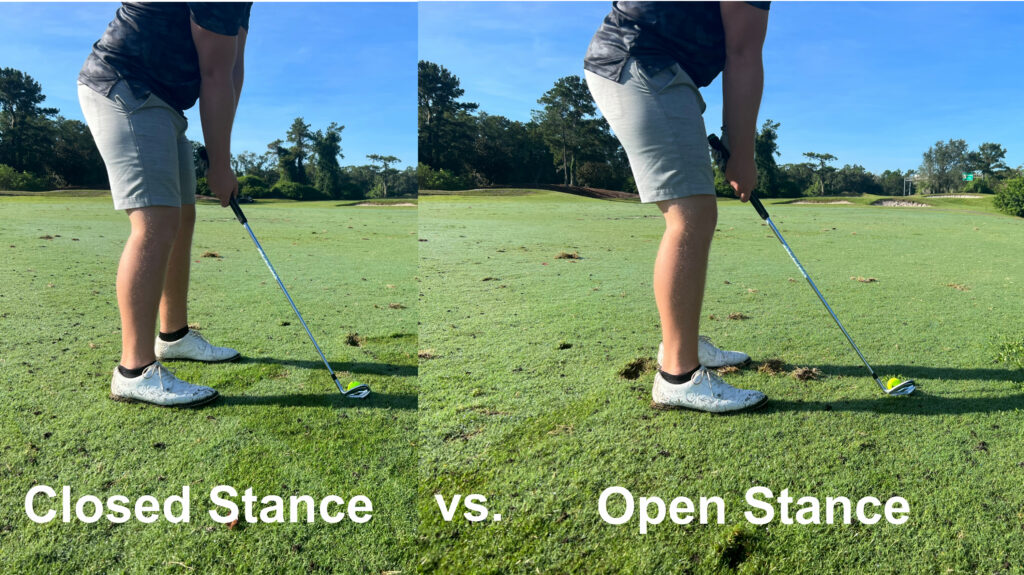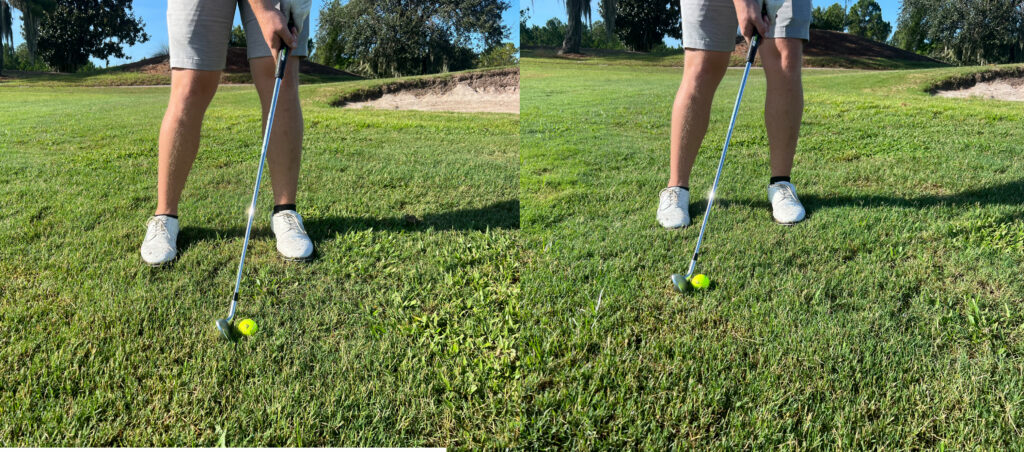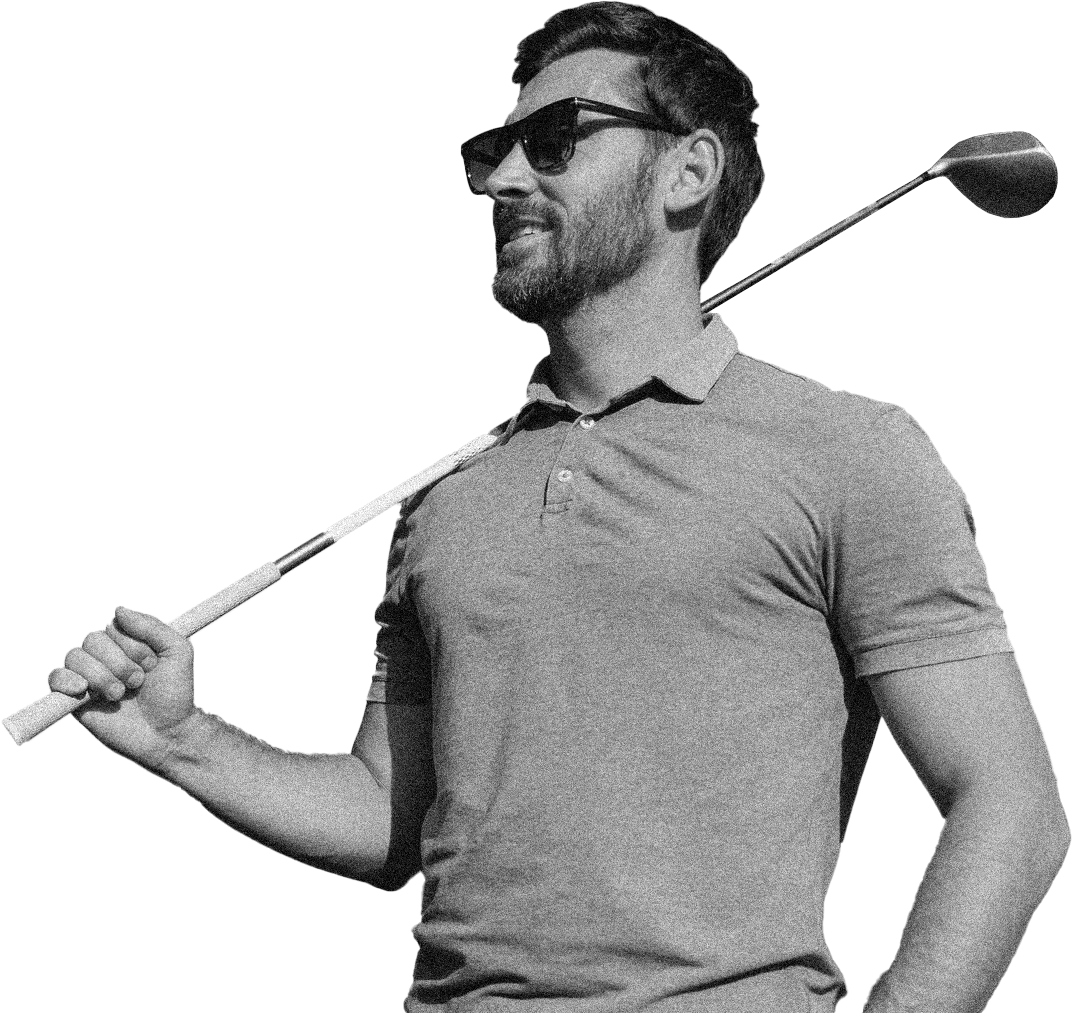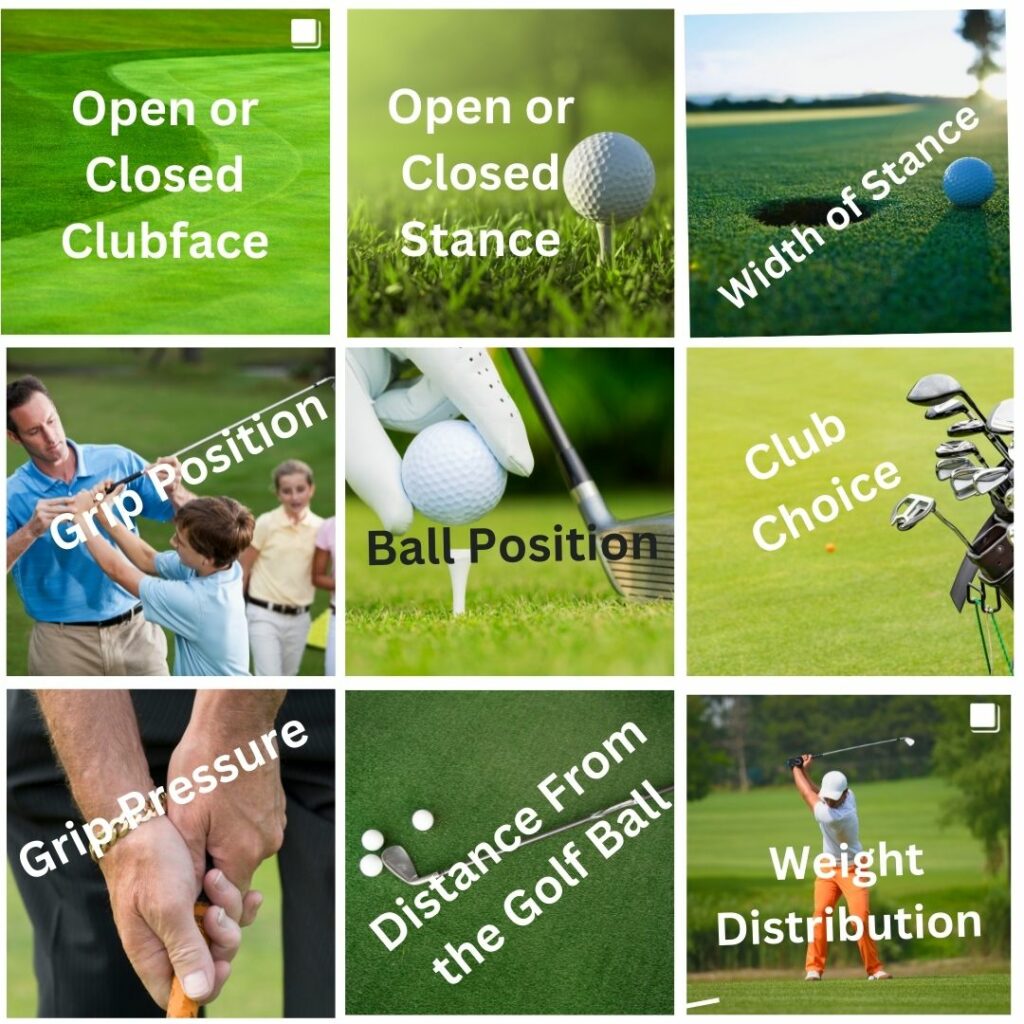When I’m coaching a client who wants to learn to control and vary the distances they hit their wedges, we start with how they set up. And how set up can greatly assist and enhance their chances of improving this often-overlooked skill. We coach this every day at my Florida Golf Academy. This month’s blog post is all about how to control your wedge shots using 9 set up variables. Not changing your swing. All 9 variables can assist you with creating great shots with all golf clubs.
What I see most often from a client expressing their interest in gaining more control of their wedge shots is their attempts to alter how they swing the club to control distances. Versus thinking through how they’ll set up differently to control their wedge shots and the distance each club makes the ball carry. As well as how to alter trajectory and spin. No matter the skill level of golfer who makes the request, changing their swing is what they go to most often.
At most handicap levels, controlling distance by changing your swing is extremely difficult to achieve. Why? Because most golfers’ swings are not repeatable, not consistent. And most golfers do not know how far each club carries to begin with. Therefore, it’s so important to understand sound fundamental setup positions. And how you can use each of your setup positions to alter a distance, trajectory, or even a directional variation of ball flight.
Why Alter Your Setup vs. Change Your Swing to Control Your Wedge Shots?
As previously stated, altering or changing a golf swing that is inconsistent to begin with, is big score waiting to happen. And for the most part, most all handicap levels of golfers tend to set up inconsistently as well. As well as fails to routinely go through a pre-shot routine to determine how to set up for any shot.
I’ve written other blog posts archived within my website that you can read about pre-shot routine and proper setup. Taking those blog posts into consideration, this blog post is going to deal with set up positions only. Not how you can change your swing. Because in essence, altering your setup positions can’t significantly increase or reduce your swing size. And in turn directly affect the outcome of ball flight. By the way, this is what we’ll teach you if decide to enroll in one of our golf schools in Florida, or elsewhere.

What are the 9 Set Up Positions to Control Your Wedge Shots?
Below are the 9 set up positions. As well as a short explanation of how each can affect the outcome of any golf shot, particularly distance control wedge shots. We’ll deal with more detailed outcomes after understanding each positional variation.
1. Club Choice
Without a doubt, this one variable is the cause of most badly played shots, from a distance perspective. Most golfers tend to choose the more lofted, shorter club choice. And attempt to hit the ball “harder.” This choice provides you the least margin of error and requires you to hit a perfect shot each time. Perfect is not something you achieve in golf, as all shots are great misses, based upon your handicap and experience level. Obviously longer and less lofted golf clubs hit the ball longer than shorter clubs with more loft. But knowing your carry yardages is essential for this variation of set up to work the best.
2. Club Choice Open or Closed at Address
A club that is open, which adds more loft to the club, produces a shorter and higher than normal shot and distance. The opposite is true for a club that is closed at address. It will decrease loft and therefore hit the ball a little longer than normal with a lower trajectory.
3. Stance Width
Varying the width of your stance communicates to your brain and body how long your swing should be. And in turn, how long you want your shot to travel. When you hit a driver, your feet tend to be the widest. But with wedge shots, your stance width should be much narrower. A narrower stance tells the body not to over swing. As well as naturally decreases the amount of clubhead speed you can produce.
4. Stance Distance
The distance you stand away from the ball can also make a difference in how far a golf shot travels. When a ball is closer to you, you’re most likely trying to hit a shorter shot. While a ball further away from you creates a wider swing arc. And in turn more clubhead speed to hit a slightly longer shot with the same club.
5. Stance Open or Closed
Varying your stance relative to your intended target also produces differences in how you swing. And in turn differences to how far the ball travels. When you open your stance, you naturally shorten your back swing. This produces less clubhead speed at impact. And less distance. Closing your stance allows for bigger back swing. Bigger back swings create more clubhead speed at impact. And more distance.
6. Ball Position
By moving the golf ball within the width of your stance, you can vary the bottom of your swing arc. As well as the direction of your swing. Moving the ball forward forces you to stay back at impact and in turn creates more loft. More loft produces a higher and shorter shot. Moving the ball position back in your stance creates a steeper angle of attack to the ball at impact. As well as a flatter clubface. Which produces a slightly longer shot with the same club.
7. Weight Distribution
For most wedge shots, having most of your weight in your front side is desirable. Particularly from your hips to your feet. But varying the amount weight can influence club speed as well as your ability to balance your swing. Generally, a more balanced swing produces a bigger swing and longer shots. Having most of your weight forward in your setup greatly reduces your ability to make a backswing and creates shorter shots
8. Hand Position on Handle
Similarly, to choosing a shorter club to produce a shorter distance, you can shorten or lengthen any club of your choosing to shorten or lengthen the shot you’re desiring to hit. Placing your hands close to the end of the grip or even onto the shaft will shorten the club. And in turn create a shorter shot. Placing your hands at the very end of the grip can produce a longer shot. Ideally, for distance control wedge shots, placing your hands in the middle of the grip is ideal. And allows for the hand position variation to work in your favor. It also produces a more controlled swing because you’re now in more control of the golf club.
9. Grip Pressure
Group pressure is an often overlooked set up position, no matter the shot. For this variation to work, you should already have a consistent grip pressure established within your full swing. And until you do, I would guard against you using this variation. Simply because it is probably the most complex of all 9 set up variations to understand its relevance, as well as its influence upon minute “feel” shots. Generally, the lighter you hold a club, the less the ball will travel. However, holding a club tighter than normal will not necessarily make a shot go further.
How do these 9 Set Up Variations Work?
In nature, we know that for every action there is an equal and opposite reaction. And set up variations work the same way. If you make a variation to 1 of the 9 set up variables, it’s going to affect one of the other 8 set up variations. And you’ll need to make a further adjustment for the second, and sometimes third variation, to correctly accommodate the first variation you chose.
For example, when you move ball position forward, you will in turn open the club. and add loft to the golf club. This is a very simple example of how one variation works to affect a second set up position.
Taking this example one step further, if adding loft opens the club and points the leading edge of the club to the right of your intended target (right-handed golfers; opposite for left-handed golfers), you’re therefore going to need to make a stance correction that places the leading edge perpendicular to your intended target. That stance correction would be opening your stance. What most golfers do instead, is to press the hands forward to straighten the leading edge. Not knowing how pressing the hands forward is actually working opposite of what they’re trying to accomplish.
Which of the 9 Set Up Variations Should I Use First?
The obvious variation to experiment with first is club choice. This is the 1st choice we insist upon at our Florida Golf Academy. Which is why it’s listed first.
Understanding how far each club carries with a normal swing is paramount to you becoming a better golfer. Without this information, all other set up variations are at best an uneducated guess. Understand and knowing your carry distance with each club, you create a standard by which you will add or subtract distance from a club. And in turn, utilize one or more set up variation to achieve the distance desired.
How do I Understand the Variations Related to My Golf Game?
Experimenting with one variation at a time is the best method to use. It allows for simplicity as well as an environment which allows you an understanding of how each variation can alter the outcome of your wedge shots.
Starting with club choice first, creating the standard by which to vary from, there is now only 8 variations to choose from. Making the calculation of distance control a bit simpler for you on the golf course, regardless of the distance you need to hit any shot. From that point, experiment with one variation that you understand the best. The variation you know you can have complete control over, no matter the situation.

Which of the other 8 Set Up Variations is Best for Me?
Most beginners start with opening or closing the club. But don’t feel compelled to start there because everyone else does. If you do start with opening or closing the club, it’s best you start with one or the other, open or closed. Allow yourself some time to understand how that one alteration affects your ball flight. Not only from a distance measurement standpoint. But from a trajectory standpoint as well.
For instance, if you choose to open the club at address and make the same swing, the shot travel a shorter distance than if you make a normal swing. As well as fly higher. If this variable does not achieve this expected outcome, then a second variation is needed to produce the higher ball flight with shorter carry. The most obvious of the variations to create this shorter and higher ball flight is opening your stance or moving the ball position forward in your stance. Each variation increases the potential loft of the club at impact while shortening your golf swing.
As you experiment, take your time. When you think you know how one variation will affect your distance control, you actually don’t know. It takes time to create averages and trends, not anomalies, in relation to how each variation slightly alters the carry distance of your wedge shots. Averages must become your standards of measurement. And in turn, the standards you vary from. Anything other than your standard will put you at risk to record higher scores.
When do I Use the 9 Variables of Set Up to Alter my Wedge Shots?
The most common occurrence of you needing to use one of the 9 set up variables to control your wedge distances is when you’re caught with a distance that is in between two clubs. For example, your wedge carries 110-yards. Your gap wedge 95-yards. And you have a 102-yard shot with a forced carry. This is a textbook situation of needing to employ one or more set up variations to achieve the desired distance.
As mentioned previously, novice golfers will attempt to control distance by controlling their inconsistent swing. This is a recipe for disaster. Set up positions can become very consistent if you practice them on a regular basis. And in turn, consistent set up positions, and understanding how each can create a slightly different distance, eliminates the need to alter your swing. Regardless of the type of shot you’re attempting to produce.
By experimenting and understanding how these 9 set up variations can slightly alter the distance you hit a wedge, you’ll be able to understand how being caught between two clubs is not as bad as it appears.
Conclusion
Why change your swing to create a distance when you can alter just one set up position to achieve the distance? Why rely upon you’re the inconsistencies in your swing when you can use variations you have complete control over that are more consistent?
All great golf shots start with a great setup. And as a golfer, the one thing you have complete control of is how you set up to any shot. Learning how to use one set up variation at a time to your advantage to alter your carry distance will immediately lead to lower scores. And more enjoyment of the game. But it will also have you better understand what your potential is, and what you can achieve within your golf game.
Use these 9 set up variations to help guide you to your next low score. Start believing that these set up positions when used correctly, will provide the distances you never thought you could achieve with an “in between clubs” yardage. As you experiment with these variations, you’ll begin to realize how valuable each will become to other parts of your game as well. When you attend one of our 1-to-1 or 2-to-1 golf schools in Florida and ask to work on your distance control wedge game, expect to work on your set up positions to achieve the results you are looking for.






